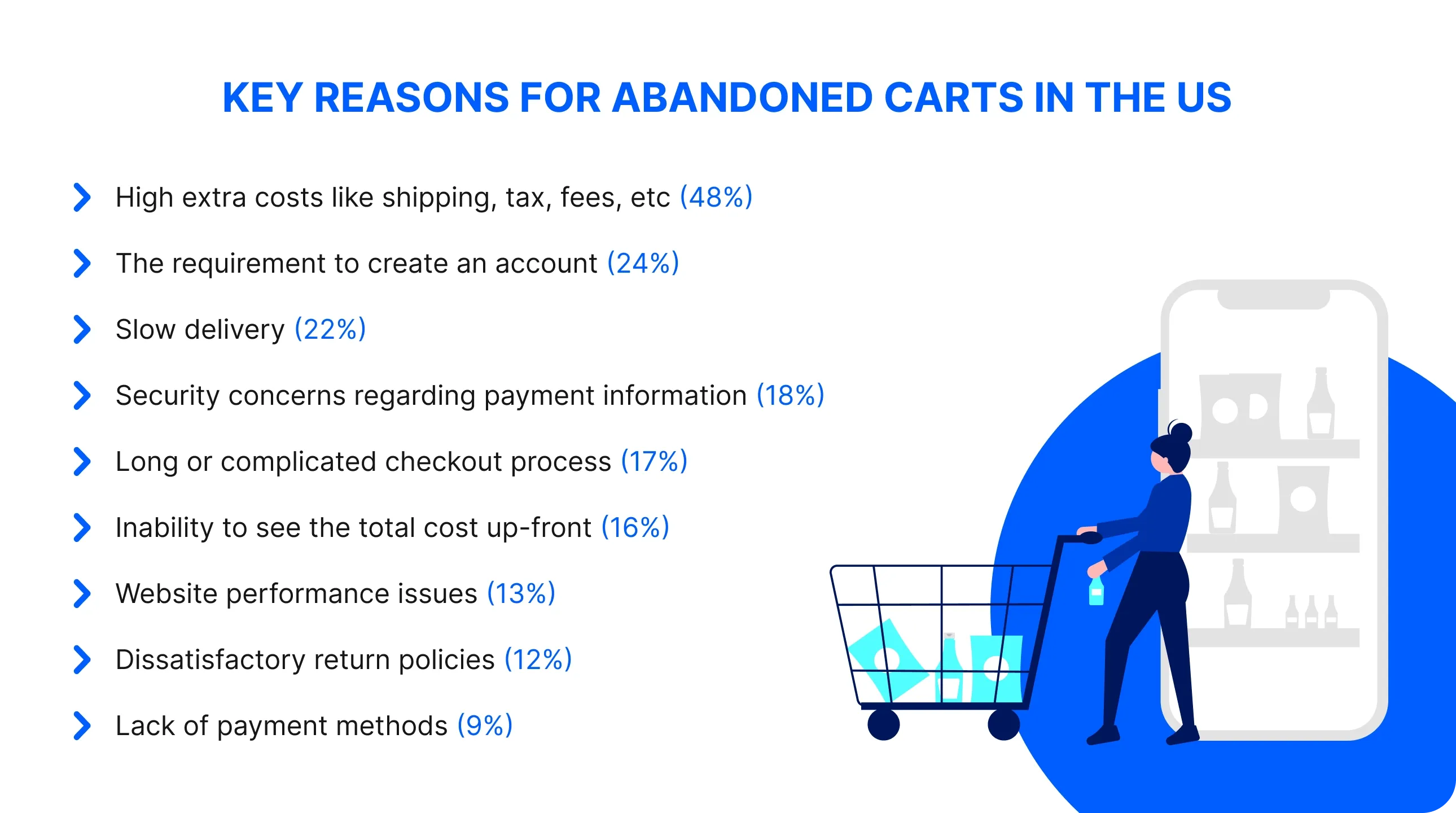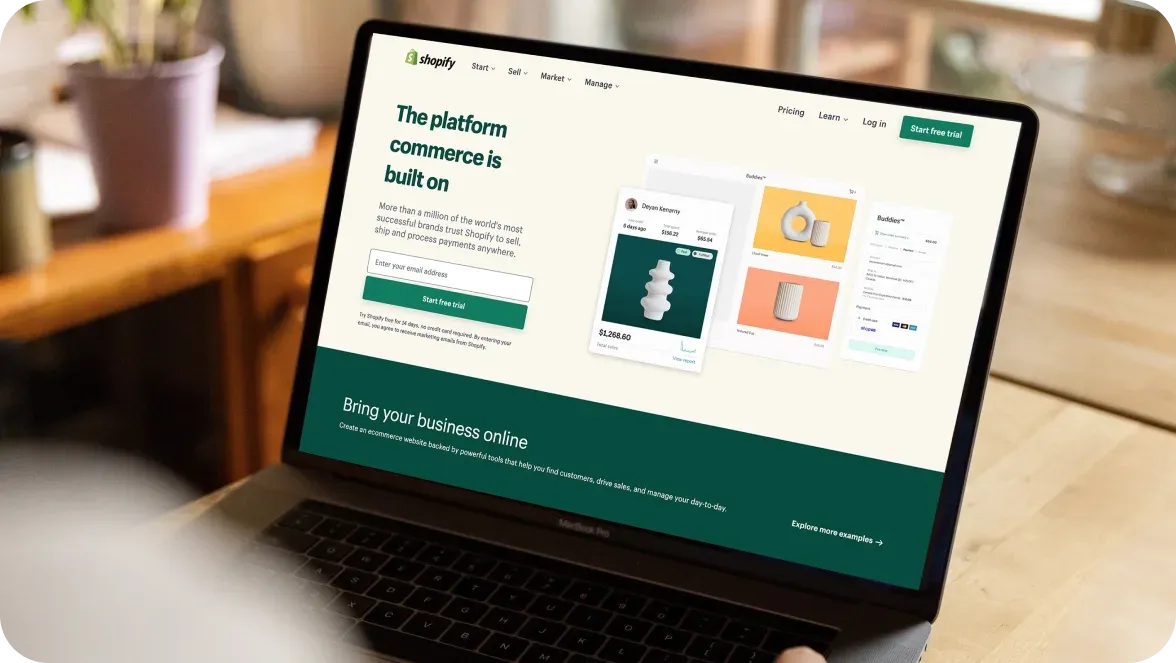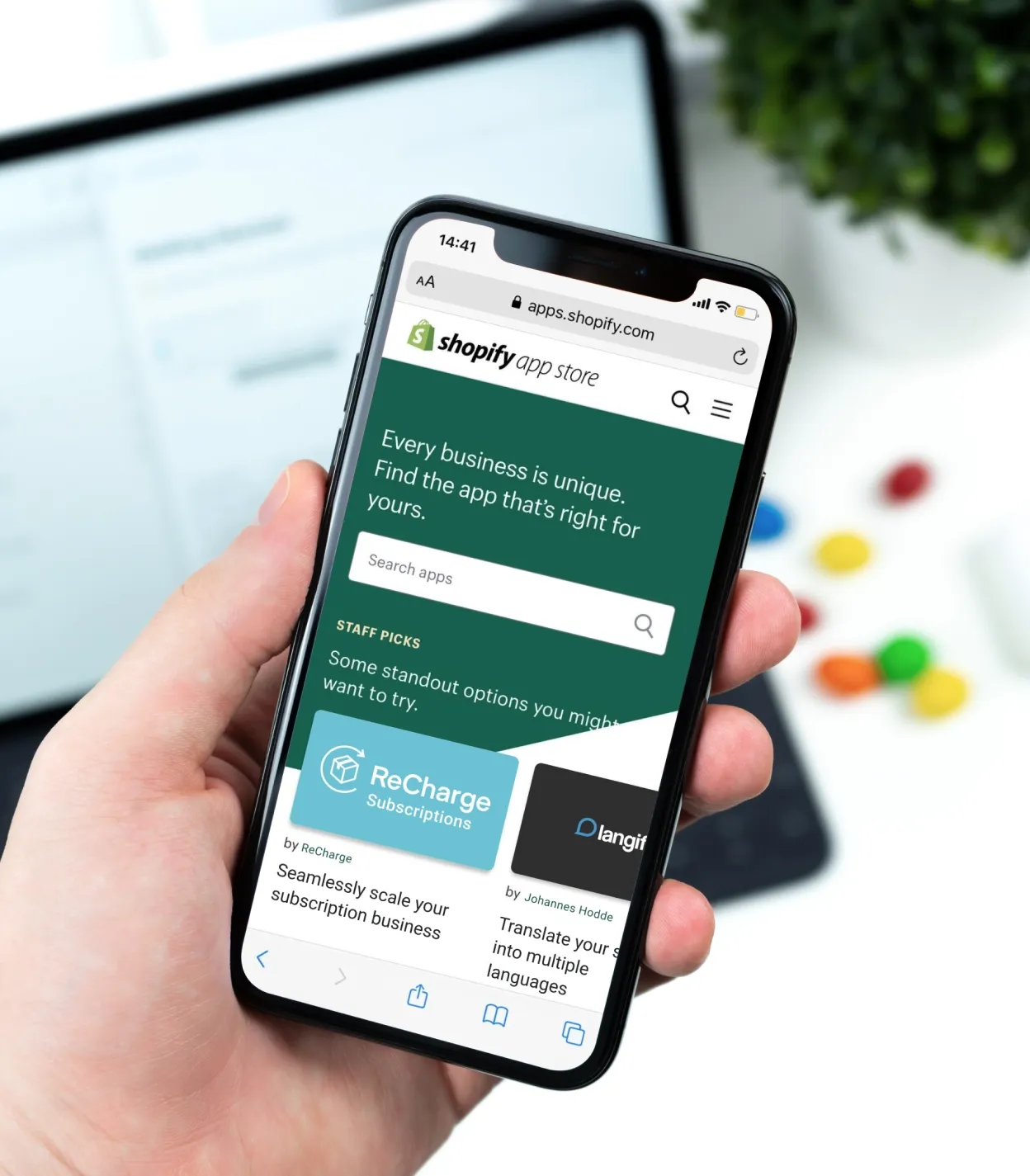
Over two-thirds of all carts get abandoned by online shoppers in the United States. The cart abandonment rate here is around 70%. But even if your store’s rate is in line with this figure, it doesn’t mean you can’t reduce cart abandonment – and increase your sales as a result.
Why do carts get abandoned? Among the U.S. shoppers, the number one reason to give up on a purchase is “extra costs too high (shipping, tax, fees)” (48%). Other reasons include the following:

Understanding these underlying causes – and which ones are at play in your store – is crucial for reducing your cart abandonment.
As a Shopify development company, DigitalSuits has extensive experience setting up effective abandoned cart recovery mechanisms in Shopify online stores. Today, we’ll share out experience with you in the form of these nine tried-and-tested tips on how to reduce cart abandonment on Shopify.
First, collect and analyze data – and test, test, test!
Before introducing any changes to your store, collect and analyze data on your abandoned carts first. This way, you’ll be able to see what changes are truly necessary – and more likely to pay off.
Here are the metrics we advise you to gather before making decisions:
When and at which stage a shopper abandoned the cart
Order amount
Items in the cart
Device used
Customer information (e.g., are they new or repeated customers?)
After you analyze this data, you’ll see certain trends. For example, you might notice a lot of orders got abandoned when the user was asked to create an account. That will mean that you should introduce guest checkout.
When you implement changes, make sure to launch A/B testing to see if they improve the cart abandonment rate. This is the only way you can track how effective the changes are – and tweak them if needed.
1. Expand your delivery and payment options
Since high extra costs can easily motivate your customer to close the tab before placing an order, reassess the shipping options you offer now. Perhaps, you can add free shipping or reduce shipping fees for certain items? Or expand the list of the carriers you work with?
Keep in mind: slow delivery can also be a reason why shoppers abandon their carts. So, make sure to offer a mix of shipping options, from low-cost or free but slow ones to speedy but more expensive ones.
You can avoid missing out on orders due to the lack of payment options, too. For example, Shopify can be integrated with over 100 payment getaways and providers worldwide, so you’ll have plenty of choices. But to reduce shopping cart abandonment effectively, make sure to add the popular payment options in your target markets.
2. Add a preview of all costs
Shoppers don’t like unexpected costs. They’d prefer to see all the costs a purchase will entail before they hit the “Checkout” button. So, here’s another tip on how to reduce shopping cart abandonment: add a preview for the total order amount before the checkout. It should include:
Shipping costs
Taxes (including any customs fees if applicable)
Any extra fees
Shipping costs, of course, may vary by location. But that’s not a problem: you can add a shipping calculator right to the product page to help your potential customers estimate the total price. To that end, you can use the in-built shipping calculator or turn to third-party apps like Shipway.
3. Check your website’s performance
Improving your website performance is one of the more obscure ways to reduce shopping cart abandonment. It would be a shame to miss out on customers who back out of placing an order simply because the website crashed or the mobile experience wasn’t great, right?
When assessing your store’s performance, check its:
Loading speed
Bugs and crashes throughout the checkout process
Mobile user experience
If you notice any website issues, fix them before considering adding new features or launching marketing automation.
4. Make the checkout process as intuitive and fast as possible
If it’s unclear which button to click next during the checkout or the process takes longer than possible, your store failed the user experience exam. The whole checkout should be as concise and simple as it can be if you want to reduce cart abandonment.
In practice, a smooth checkout process means that:
Every link and button has a clear CTA
Checkout steps are also clear, presented in the form of a road map
The checkout form requires as little information as possible
The payment options include one-click or one-tap payments (e.g., Apple or Google Pay)
Accepting or refusing cookies is a matter of a couple of clicks
While the user experience depends on your design, feature choices, and copy, the theme sometimes brings it down. If you realize it’s your case, consider customizing the theme to improve the checkout flow or switching to another one.
5. Offer free return and complete refund policies
Dissatisfactory return and refund policies, while not leading causes of cart abandonment, still play a role in building trust. If it’s the person’s first time buying from you, they may not be sure if this product will meet their expectations in terms of size, quality, or fit.
So, adding free return and complete refund policies will be a compelling argument for hesitating customers. Even if the product doesn’t fit them, they don’t risk losing anything.
Make sure your policies are clearly stated on the product page and during checkout. It can be as simple as one sentence, with a paragraph below describing the policy in more detail.
6. Add a “save cart” feature
With the help of a third-party app, you can reduce shopping cart abandonment by allowing your users to save their carts by clicking a button – or do it automatically for them. This way, their unfinished order will be waiting for them the next time they visit your store. You can also add an extra notification to highlight the saved cart during the next visit.
Consider improving customer experience by adding an omnichannel automatic ‘save cart’ feature, too. In this case, customers’ carts will sync across devices. This is extremely helpful for users who found your mobile website lacking something or just prefer to enter their payment details on another device.
Adding a save cart button isn’t possible out-of-the-box in Shopify, so you’ll need a third-party app for that end. The same goes for omnichannel cart sync. Apps like Cart Saver can help you out here.
7. Make guest checkout possible
While retailers would love all new customers to create accounts for marketing purposes, it can only irritate a first-time shopper. According to the survey we mentioned, 24% of U.S. shoppers stated it was the reason they backed out of placing an order.
First-time customers simply may not be sure if they want to start a long-lasting relationship (and share their personal data) with you. So, don’t push it: get rid of obligatory account creation if you have it now.
In the Shopify admin panel, you can select “Accounts are optional” to allow shoppers to make purchases without an account. At the same time, users with accounts will still be able to use them for checkout.
8. Address potential security concerns
Hesitating to trust a website with their credit card information is still why some shoppers abandon their carts. So, if you run a relatively new store, you may be one of those websites to which first-time shoppers aren’t immediately ready to give their credit card details.
In this case, there are multiple ways you can build trust with first-time shoppers in numerous ways. First, pay attention to your website’s design and functionality. Poorly designed and buggy websites automatically lose credibility.
Then, break down what you do regarding data security to protect user data. This can include working with PCI-compliant payment getaways, using 256-bit SSL encryption, and more. You can also acquire a security trust mark from companies like Norton or Verisign.
9. Consider adding exit-intent popups
While it’s another popular tip on how to reduce shopping cart abandonment Shopify has to offer, use it with caution. While exit-intent popups can sway shoppers to finalize their orders, they can have the opposite effect as easily.
How do you avoid irritating customers with exit-intent popups? Consider the value your popup delivers. You can include a special discount or coupon for hesitating customers, for example. You can also leverage FOMO by showing that this item is in high demand at the moment.
As for the technical side of adding exit-intent popups, you’ll need to turn to a third-party app to do so. Privy and Pop-Up Window are the ones that specialize in popups. However, you can also consider an abandoned cart app like Abandoned Cart Recovery by Marsello or Rivo. They come with a wider range of features, making them a better investment.
5 more ways to reduce cart abandonment
The nine methods above are the most commonly used – and efficient – ones. However, depending on your particular case, these five other ways to recover abandoned carts can also help you out:
Adding social proof to your website (user-generated content, reviews, etc.)
Implementing a customer support live chat option for users who get stuck during the checkout
If users abandon carts more often at a certain time of the year, consider launching sales in those dates
Using FOMO-inducing techniques during the checkout: limited-time offers on shipping, limited stock, etc.
Offering payment plans if the average order amount is high
And if the cart got abandoned…
…You can still recover it! Yes, even if the user left your website without finalizing their order, it’s still possible to get them to return to it. How? Here are the two abandoned cart recovery methods you can try.
Create an automated email, push notification, and SMS campaign
A common e-commerce website promotion idea, abandoned cart emails, SMS, and push notifications can help you reduce shopping cart abandonment. They can serve as a reminder about the cart and contain the list of items added, along with a catchy CTA.
There’s one caveat, however: these messages often have to be more than just well-written and aesthetically pleasing. They have to include a compelling argument for the person to consider going back to their order.
So, besides an excellent copy, great design, and an irresistible CTA, deliver value to your customer via that message. It can be a promo code, access to private sales, or a gift. You can also highlight how popular this or that item is to encourage the shopper to decide faster.
We recommend you turn to third-party apps to create and automate a comprehensive campaign. Marsello’s Abandoned Cart Recovery is a well-rounded, while PushOwl, Omnisend, and Campaign Monitor specialize in push notifications or email marketing.
With apps like Recart, you can also remind prospective customers about their abandoned carts via Facebook Messenger. In addition, the whole campaign can be automated, with customizable templates available.
Consider launching retargeting ads
A retargeting ad campaign targets the users that visited your website and left without purchasing anything. You can launch them on social media (Facebook, Instagram, etc.) or using Google Ads with the help of the data gathered via cookies.
If you want to launch a retargeting campaign, set the ads to appear to the person a couple of days after they visit your store. The ads typically contain a photo of the item abandoned, along with a short CTA and, sometimes, a special discount or offer.
As for the technical aspect of retargeting ad campaigns, you’ll need to install and set up the Facebook & Instagram app from the Shopify store to work with these social media platforms. To expand the range of channels, you can also try Dynamic Retargeting Ads to launch campaigns with Google Ads.
While it can be one of the ways to reduce shopping cart abandonment, the click-through rate is still relatively low: only 0.7%, according to one estimate according to one estimate). However, it’s still more efficient than regular ads (their CTR is 0.07%, on average).
In conclusion
There are many ways you can try to reduce cart abandonment and recover some of those orders. But which ones will work the best in your case depends on your current metrics. As soon as you pinpoint what drives your customers to leave their orders unfinished, you’ll understand which methods have the biggest potential to turn things around.
Need some help in recovering shopping carts as efficiently as possible? We’re here to help you out! As a Shopify app development company, we know all the ins and outs of introducing the right changes to reduce shopping cart abandonment. Drop us a line to discuss your store!
FAQ
What are the key factors influencing the shopping cart abandonment rate?
Your shipping and payment options, guest checkout features, and the simplicity of the process all play a role in the cart abandonment rate. If your store is buggy and isn’t mobile-optimized, your return and refund policies aren’t on par with customer expectations, or you lack popular payment methods, that can drive up the cart abandonment rate, too.
What causes cart abandonment?
Unexpectedly high additional costs (shipping, tax, etc.) are the leading cause of cart abandonment in the United States. The runners-up are the lack of guest checkout, slow delivery, and security concerns. An overly complicated checkout process and a lack of payment methods can also increase cart abandonment rates.
What is the best strategy to recover abandoned carts?
The best strategy depends on why your customers don’t finalize their orders. Identify those underlying causes first, and you’ll be able to develop your strategy. It may include adding free or low-cost shipping options, improving your website performance, simplifying checkout, and sending reminders about abandoned carts.




































Was this helpful?
0
No comments yet